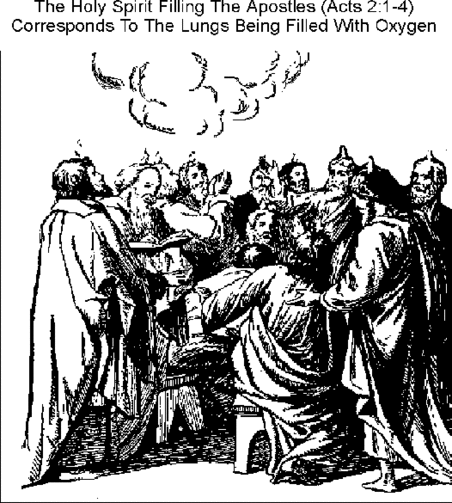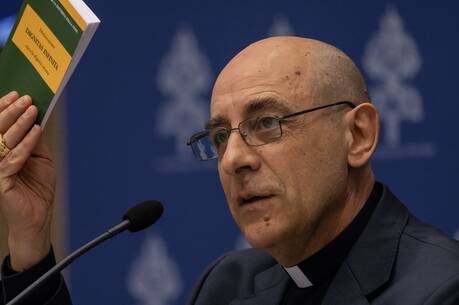Cambridge, MA. (Written on Pentecost Sunday, after Mass and after pondering the sunlit trees shaking their bright leaves in the morning breeze.)
If, on this feast of Pentecost, we delve into the technical language of Trinitarian theology—Trinitarian processions, Filioque, and the rest—we may find the terminology of the Trinity, and all the more, of the Holy Spirit, somewhat intimidating, perhaps very dry indeed. But because it is Pentecost, a day of inspiration and imagination, we do well first to remind ourselves how simple and vivid is the basic symbolism of the Spirit. Whenever the wind blows, though we cannot see it, we feel it, and see the trees moving in the wind; when we open a window after the long winter, we feel the fresh air flow into the room; when we quiet down and pay attention to how we are, we notice the in-breathing and out-breathing that keep us alive. Breath, wind, spirit, Spirit, are everywhere. Thus we begin to appreciate Pentecost, by recognizing that the freedom and “everywhere” motion of the Spirit—or just by paying attention, on a spring morning like today.
Much of reality reminds us of the Spirit, unseen, everywhere. We confirm this instinct when we look at the rich set of readings available for Pentecost and its Vigil (which suggests no fewer than four opening readings), we can see at work the play of images of God’s spirit: in Ezekiel 37, the spirit comes upon the dry bones and brings back to life that which was dead; in Joel 3, the spirit descends upon the people: “Thus says the Lord: I will pour out my spirit upon all flesh. Your sons and daughters shall prophesy, your old men shall dream dreams, your young men shall see visions; even upon the servants and the handmaids, in those days, I will pour out my spirit”—and of course these are the words Peter quotes in Acts 2, to describe the descent of the Spirit. In I Corinthians 12, it is the Spirit that brings the community together as a living organism: “As a body is one though it has many parts, and all the parts of the body, though many, are one body, so also Christ. For in one Spirit we were all baptized into one body, whether Jews or Greeks, slaves or free persons, and we were all given to drink of one Spirit.” Just as a living body is whole and one, but disintegrates into pieces when the breath leaves it, so too the church: without the Spirit, it is merely the sum of members competing and distrusting one another. When, in John 20, Jesus breathes on his disciples in the upper room, they are given the power to bind and to loose—but also, more simply, to be at peace—as if to say: calm down, take a deep breath, be at peace.
And, of course, the theme of prophecy and speaking aloud in the name of Jesus—the famous Pentecost scene itself—is at its most basic level also grounded in breath, for it is breath, marvelously finding its way to articulation in our mouths—throat, tongue, teeth—that yields the marvel of speaking: no speech without breath, neither ordinary every day words or the most exalted words of testimony. No breath, no fire.
The very idea of spirit, Spirit, invites meditation farther afield. I cannot help but think here of the prana—breath or vital force—so often spoken of in ancient India, in the Upanisads and then too in the texts of yoga: this prana is the life force, breath itself, but also more broadly, inner vitality. The ancient Brhadaranyaka Upanisad, for instance, speaks of the prana well over one hundred times. Near its beginning, in I.3, a competition of the senses leads to the obvious conclusion that while sight or hearing, though invaluable, are not essential to life, without the prana, life ends quickly; because revelation existed in a recited form, prana was basic too to the very life of that revelation as heard in this world. In provocative though not quite Trinitarian language, the Upanisad goes on to meditate on prana as a cosmic and divine and human power:
[In the beginning], three he designed for himself: the mind, the organ of speech and the prana; these he designed for himself. These are the three worlds. The organ of speech is this world, the mind is the sky, and the prana is that world… These are the father, mother and child. The mind is the father, the organ of speech the mother, and the prana the child…. Whatever is unknown is a form of the prana, for the prana is what is unknown. The prana protects him (who knows this) by becoming that (which is unknown)… Heaven is the body of this mind, and that sun is its luminous organ. And as far as the mind extends, so far extends heaven, and so far does that sun. The two were united, and from that the prana emanated. It is the Supreme Lord. It is without a rival. A second being is indeed a rival. He who knows it as such has no rival. (I.5.3-4, 7, 10, 12) (Swami Madhavananda translation, adapted)
This is no place for an exposition of the large topic of the role of prana in yoga, but we can recall that pranayama—breath control, the focusing of the breath—and there are many sites online that explain pranayama in yoga. For instance, look at the resources at a site such as Yoga Basics, or at the Christians practicing yoga site. See also my post during Lent in 2013. For the feel of its teaching, here are the low-key, instructive sutras of Patanjali on the topic of the prana (breath, in- and out-breath):
After a steady position is established, then comes control of breath, interrupting the motion of in-breath and out-breath. Breath control’s motion can be external, internal, and stopped, and these are closely observed according to time, place, and number. Such breaths are long or subtle. A fourth state of breath control puts aside both external and internal breath movements. After this, the obscuration of light is destroyed, and there is fitness of mind for acts of focusing (Yoga Sutras II, 49-53).
Once we are paying attention, practicing, learning, we can then again look for parallels closer to home, in the Ignatian Exercises. For example, Patanjali’s instructions on breathing may well enhance our following the third method of prayer recommended by Ignatius in the Exercises:
The Third Method of Prayer is that with each breath in or out, one has to pray mentally, saying one word of the Our Father, or of another prayer which is being recited: so that only one word be said between one breath and another, and while the time from one breath to another lasts, let attention be given chiefly to the meaning of such word, or to the person to whom he recites it, or to his own baseness, or to the difference from such great height to his own so great lowness.
Patanjali might find the words unnecessary, and the pairing of breaths and thoughts unnecessary: just breathe, that is God’s spirit, but for those of us who are Christian, it is worthwhile too to give voice to the presence of this spirit as we know it, the Spirit sighing with us, leading us in the Son to the Father.
Practice is key, but theology is important too, and at this point one could at this point go deeper, looking into how various theologies of the Holy Spirit do (or dont') open paths of interreligious learning and exchange. This is because the Spirit—always the Spirit of Christ—is at work everywhere in the world, certainly beyond the bounds of explicit Christianity. I recommend here looking into the writings of Jacques Dupuis, S.J., who wrote eloquently and daringly on the importance of the Spirit to the Christian understanding of other religions. But for now it will suffices to quote Jesus, in John 3: “The wind blows where it chooses, and you hear the sound of it, but you do not know where it comes from or where it goes. So it is with everyone who is born of the Spirit.”
At Pentecost, let us keeping looking within us and around us, and in the most vital possibilities of church and world, to celebrate God’s Spirit.







